August 1, 2008
Air Date: August 1, 2008
FULL SHOW
SEGMENTS
Congress Takes on Chemicals
View the page for this story
Congress is venturing into new regulatory territory with a recent ban on several varieties of the plasticizing chemicals known as pthalates. Usually government agencies regulate products on the market, but environmental health advocates say this latest ban shows Congress is picking up the slack on chemical regulation. Host Bruce Gellerman talks with Andy Igrejas of the Pew Charitable Trusts’ Environmental Health Campaign. (05:30)
Worker Safety
View the page for this story
Celeste Monforton of the George Washington University School of Public Health was perusing the Department of Labor website when she found some fine print. The Department was proposing allowing worker exposure to higher levels of chemicals, though for shorter periods of time. She published what she discovered in her blog and shares it with host Bruce Gellerman. (05:45)
Few Rules on Nanotech
/ Jeff Young and Mitra TajView the page for this story
As questions continue to grow about nanotechnology's potential dangers, so do concerns about how the small stuff should be regulated. Reporter Jeff Young continues Living on Earth's series "Let's Get Small" with a look at why federal agencies have yet to meet the regulatory challenge. Then Living on Earth's Mitra Taj takes us to Cambridge, Massachusetts, where lack of federal action has left the city to figure out what to do with nano in its own backyard. (10:00)
For Whom the Roads Toll
View the page for this story
Americans are easing up on the gas as the price of gasoline remains high. It means shrinking funds in federal highway coffers. One of the ways Congress is considering raising the 1.6 trillion dollars needed to repair the nation’s transportation infrastructure is through tolls on federal roads. Host Bruce Gellerman speaks with the Wall Street Journal’s transportation reporter, Christopher Conkey. (06:30)
The Way of the Dodo
View the page for this story
Discovered only in 1973, by 2004 the population of the Hawaiian honeycreeper, known as the po'ouli had dwindled to a mere three birds. In "The Race to Save the World's Rarest Bird," science writer Alvin Powell recounts the bird's story. Host Bruce Gellerman talks with Mr. Powell about the surprising discovery of the bird and its untimely demise. (08:10)
Clean Water for Kenya
/ Jessica PartnowView the page for this story
In Kibera, a slum of Nairobi, Kenya, clean water is too scarce. But a new technology that takes just a plastic bottle and six hours in the sun is helping reduce sickness and diarrhea in the community, and in other developing countries around the world. Jessica Partnow reports. ()
Show Credits and Funders
Show Transcript
HOST: Bruce Gellerman
GUESTS: Chris Conkey, Andy Igrejas, Celeste Montforton, Alvin Powell
REPORTERS: Jessica Partnow, Mitra Taj, Jeff Young
[THEME]
GELLERMAN: From Public Radio International—this is Living on Earth.
[THEME]
GELLERMAN: I’m Bruce Gellerman. Despite warnings from the industry, Congress decides not to play around with toxins in toys.
IGREJAS: Congress was starting to look at some of these claims of – oh, there’ll be no toys – you know - it’ll be a year without Santa Claus if you pass this – and I think they started to look at this skeptically because that kind of argument doesn’t fly – there are toys in Europe they’re just safer.
GELLERMAN: Also birds of a feather don’t always flock together – and for the rarest bird of all – that spelled disaster.
POWELL: So you have this tragic situation on this high rainy mountainside on Maui, where the last three of this species are sitting there near each other, but in separate home ranges, perhaps not even aware of each other.
GELLERMAN: The extinction of a species – it’s not just a problem for the birds – and making drinking water safe – one bottle at a time. These stories this week on Living on Earth. Stick around!
[NPR NEWSCAST: Boards Of Canada “Zoetrope” from “In A Beautiful Place Out In The Country” (Warp Records 2000)]
Congress Takes on Chemicals

A future of phthalate-free rubber duckies? (Courtesy of Breast Cancer Fund)
GELLERMAN: From the Jennifer and Ted Stanley Studios in Somerville, Massachusetts - this is Living on Earth. I’m Bruce Gellerman, in for Steve Curwood.
In an unusual move, Congress has banned some members of a family of chemicals called phthalates. Phthalates are found in tens of thousands of products including plastic toys - shower curtains - adhesives, cosmetics and shampoos. The federal ban, which goes into effect in six months, applies to three kinds of phthalates – and follows bans enacted by California, Washington, and Vermont. Supporters of the federal ban see this as just the first step towards tougher national standards for other chemicals used in consumer products. The Pew Charitable Trust was among the groups that pushed for the phthalate ban. Andy Igrejas manages the Pew’s Environmental Health Campaign. Welcome to Living on Earth!
IGREJAS: Thank you.
GELLERMAN: This is actually a rare action by Congress, isn’t it? I mean usually it’s the federal regulatory agencies like the EPA that would get involved with banning a chemical. I can’t remember the last time they banned something like this.
IGREJAS: That’s true. Congress has not often banned chemicals. They banned PCBs in the 70s. But they’re doing it now because they’ve realized that the, unlike some of the major environmental laws that we have like the Clean Air Act and the Clean Water Act that have basically been functioning and working, the law that deals with this has not been functioning, it has not been working. And it’s resulted in chemicals in toys and in cosmetics and in other consumer products that have health problems associated with them and where no one is really minding the store.
GELLERMAN: Well right now the way chemicals are dealt with in the United States is they’re innocent until proven guilty. In the EU they have something called a REACH program, which is just the opposite—they have to prove something is safe in the marketplace.

Andy Igrejas of the Pew Charitable Trusts Environmental Health
GELLERMAN: So are there American companies manufacturing products that meet the European standards for safety, much more strict than the standards here, and that the products they sell here wouldn’t meet those that they’re producing for Europe?
IGREJAS: Absolutely. One of the problems I think for the chemical industry is that Europe is a major market for American companies and they’re now having to comply with European standards. And it gets very hard to say that this is going to be the end of the world if you have to do this here if you’re already having to do it for Europe. And particularly if you’re having to do it both for Europe and for a major state. And that is the problem I think they’re facing and that’s why Congress was starting to look at some of these claims of, “Oh, we won’t be able to, there will be no toys, it will be the year without a Santa Claus if you pass this.” And I think they start to look at this skeptically because that kind of argument doesn’t fly. There are toys in Europe, they’re just safer.
GELLERMAN: When I go into a store, the products aren’t marked phthalates, there’s no ingredient list. So how would I know if it is or isn’t in a product?
IGREJAS: It’s very hard. I think that for a consumer there isn’t really a labeling system that allows the consumer to judge these questions. Some companies and some stores will wind up pointing out that these toys are phthalate-free and that kind of thing. With cosmetics for example, phthalates used to be on the label for some things but they didn’t have to be on the label if they’re considered a component of fragrance so they wouldn’t be on the label for some products that I know my own organization had found them in when it did product testing. And the consumer can’t sit there and have its chemistry set at home and test these products so we need the government really to be doing that. And that’s why we do think that this issue of the chemicals in toys is sort of a harbinger of what’s gonna come with chemicals more generally. That Congress has seen how that system is broken and will revisit that law—it’s called the Toxic Substances Control Act—and basically try and make it more protective.
GELLERMAN: Well it is a one and a half billion dollar industry, the petrochemical industry put up a vociferous fight, you know, what are the economic outcomes here of a ban?

Rubber duckies might be free of phthalates in the future. (Courtesy of Breast Cancer Fund)
GELLERMAN: Well, Andy Igrejas, thank you very much.
IGREJAS: Thank you.
GELLERMAN: Andy Igrejas manages the Pew Charitable Trust’s Environmental Health campaign.
Related links:
- Breast Cancer Fund
- Pew Charitable Trusts
[MUSIC: Coldplay “Lovers In Japan” from ‘Viva La Vida’ (EMI Records—2008)]
Worker Safety
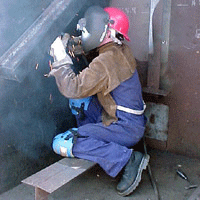
The Department of Labor’s proposal could double welders' legal exposures to hazardous chemicals. (Courtesy of the Department of Labor Occupational Safety and Health Administration)
GELLERMAN: Celeste Monforton scrupulously scans obscure White House websites. Early in July Monforton was digging deep into the administration’s site for The Office of Information and Regulatory Affairs and there she found a nine-word sentence written in federal bureaucratese – that could fundamentally change the way the government determines workplace safety. Monforton, a lecturer and research associate at the George Washington University’s School of Public Health wrote about the Administration’s sweeping proposal that she found buried in a website on her blog: The pump handle.
MONTFORTON: This proposal is addressing the process by which the two main agencies in the Department of Labor, OSHA and MSHA (the Mine Safety Agency), regulate occupational health hazards.
GELLERMAN: And OSHA is the Occupational Safety and Health Administration.
MONTFORTON: Correct. It mandates an unnecessary step at the front end of that process which will, in my estimation, delay protections by at least two or three years. And when you think about worker safety and health, two or three years is two or three years of additional exposure to those chemical contaminants day in and day out.
GELLERMAN: Well as I understand it, the existing regulations assume that workers are going to be at the same job for 45 years and the proposal here is to change that.
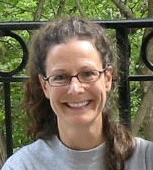
Celeste Monforton is a Lecturer and Research Associate at the George Washinton University’s School of Public Health and Health Services. (Courtesy of Celeste Monforton)
GELLERMAN: So what is the proposal that the Department of Labor is proposing?
MONTFORTON: The Department of Labor is proposing that the assumption that people work 45 years is flawed and that it should be based on the average number of years that people work in a particular industry. They believe that on average most people don’t work 45 years so if you’re going to develop a new standard on chemical X, you don’t need to set a protective level that’s based on someone that might work there 45 years you should only set it based on that they’re going to work there on average 10 years.
GELLERMAN: Well but they have a point there, right? People don’t ordinarily work in jobs, the same job, for 45 years?
MONTFORTON: Well, I think that it’s correct that on average people don’t work in a particular job for 45 years. But we know that these standards are meant to be protective and that we know individuals who do work in jobs for more than 30 years. I just was speaking with a woman who’s a housekeeper, a hotel housekeeper; she’s worked for 46 years. So her exposures definitely wouldn’t be covered if there was a standard put in place and someone wanted to say, “Well let’s just protect for the average.” That’s not what public health is about. It’s not about just protecting the average individual, it’s protecting the whole population of individuals, even those that have exposures for 45 years. And we know that in particular types of occupations—if you’re a tradesman that is a welder, or a plumber, or an electrician—you probably do that job for 45 years, it’s not something that you just do for a couple of years and then you take up a new career.
GELLERMAN: So this proposal by the Department of Labor which you caught on this obscure website is a little bit unusual in terms of the way it’s made public?
MONTFORTON: Absolutely. The thing that’s really, for me, that very nefarious about this whole process is the two agencies that have the most experience and actually do risk assessment as part of their responsibilities were not involved in developing this proposal. They actually contracted it out and paid 347,000 dollars to individuals to work on this. So it was, you know they excluded people within the agency who have the most experience doing this.
GELLERMAN: Didn’t the National Academy of Sciences look at this specific issue back a few years ago?
MONTFORTON: Absolutely. This is something that when I saw it on the website, it really piqued my interest, because in 2006, the White House attempted to put in place comprehensive guidelines for risk assessment that would have gone across the board for all agencies. And when that was released, the scientific community and public health advocates and environmental health proponents looked at that and saw how damaging it would be for public health and environmental health.

The Department of Labor’s proposal could double welders' legal exposures to occupational hazards.(Courtesy of the Department of Labor Occupational Safety and Health Administration)
GELLERMAN: I have to ask you Ms. Monforton, what are you doing looking at this obscure website?
[MONTFORTON LAUGHS]
MONTFORTON: I’ll try to answer that question. As public health researchers here in Washington, D.C., we look at, part of our responsibility to show the rest of the country what’s going on here in Washington with respect to worker safety and health, and so we just make it our practice of checking out those websites, and finding out what is in the pipeline and over the course of this administration much of what has been in the pipeline is not protective of worker safety and health. So we also recognize that in the last six months of this administration they may try to put things in place that they haven’t yet had a chance to do. So our eyes and ears are always open for those last minute moves that might be detrimental to workers.
GELLERMAN: Well Ms. Montforton I want to thank you very much.
MONTFORTON: Thanks Bruce. Thanks so much for asking about this.
GELLERMAN: Celeste Montforton is a lecturer and research associate at the George Washington University School of Public Health and Health Services. Her blog is called “The Pump Handle.”
[MUSIC: Marc Ribot “ShSh ShSh” from ‘Party Intellectuals’ (Pi Records—2008)]
GELLERMAN: Coming up: Small things considered – big rules for tiny tech. Just ahead on Living on Earth.
Related links:
- Pump Handle Blog
- Defending Science on the Department of Labor’s Proposal
- Department of Labor Risk Assessment Proposal
[MUSIC: Roy Hargrove: “Starmaker” from Earfood (Emarcy records 2008)]
Few Rules on Nanotech

Cambridge, Massachusetts, is the third U.S. city to debate regulating nanotechnology. (Photo: Rick Umali)
GELLERMAN: It’s Living on Earth, I’m Bruce Gellerman. Businesses based on the science of very small things - nanotechnology - are booming. But as tiny materials become commonplace in consumer products their use raises big questions about health and safety. Today we continue with a series of stories about nanotechnology we call “Let’s Get Small” - with a look at the problems government agencies large and small face regulating nanomaterials. We have two reports: coming up – how cities are trying to get a handle on nanotechnology. But first our Washington correspondent Jeff Young explains why there are still no federal rules governing the growing nanotech industry.
YOUNG: Down at the nano scale - a billionth of a meter - things can get weird. Scientists who study nano materials like to tell a little story about that, the story of the shrinking cat. Here’s how Andrew Maynard at the Woodrow Wilson International Center for Scholars tells it:
MAYNARD: Imagine you take a cat and you can shrink that cat to make it smaller…
[SOUND OF A CAT MEOWING]
MAYNARD: - and smaller…
[FAINTER MEW]
MAYNARD: And smaller…
[VERY FAINT MEW]
MAYNARD: And you look at it and it looks small but it still looks like a cat, still sounds like a cat, still smells like a cat. But then imagine you get to a point where you shrink it down and all of a sudden…
[WOOF, BARKING NOISE]
MAYNARD: It turns into a dog. Absolutely incredible behavior! You wouldn’t believe it would happen. But nanotechnology is just like that. It does the same thing as changing from cat into a dog. So this is something where the chemistry doesn’t change, you’ve still got the same atoms there, but the behavior changes radically at the nano scale.
YOUNG: That points to what’s so promising and perplexing about nanomaterials. They could soon revolutionize manufacturing and medicine. But when otherwise ordinary materials behave in unexpected ways they throw a tiny monkey wrench into our system for keeping products safe. Maynard’s research found one example of this: Carbon nanotubes, which are already in products from car parts to tennis rackets. Maynard and other researchers noticed that some carbon nanotubes in long fibers seemed a lot like another well-known fiber - asbestos.
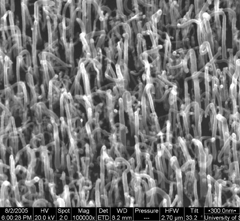
Too small to be seen by the naked eye, each of these carbon nanotubes measures about 40 nanometers (or 400 atoms) across. (Photo: St Steve)
YOUNG: But chemically Carbon nanotubes are still just carbon - the same as the graphite in your pencil. And that’s the little monekywrench. Much of our current system for regulating hazards is based on the chemical makeup of the material in question. But with nanomaterials, it’s size that matters.
[NOISE OF A CROWDED ROOM]
MODERATOR: We’re going to try to get started…
YOUNG: Policy advisors and scientists packed a recent meeting at Washington’s Woodrow Wilson Center to learn more about the nanotech challenge to the regulatory system. Terry Davies, a senior fellow at the Washington think tank Resources for the Future, told them current federal safeguards are not up to the job.
DAVIES: The protection is completely inadequate in terms of assuring public that nanomaterials are safe even those kinds of nanomaterials that people us on their bodies or that they swallow or whatever - in baby rattles and teething rings all bunch of things like that - there is no government oversight with regard to health and safety.
YOUNG: Davies recommends much more safety research funding. He says the Food and Drug Administration should have more authority over cosmetics and dietary supplements. And he says laws on toxic substances should expand to let regulators look beyond chemistry for potential hazards. But those changes are complicated, partly because there are two dozen federal agencies involved. It is Clayton Teague’s job to keep them straight. Teague directs the National Nanotechnology Coordination office. He says each agency is clarifying how to apply existing rules. But they want to know more
before considering any new regulations.
TEAGUE: Once we truly have adequate info about any potential hazards this may happen. But I think to do so without adequate scientific information would just be inappropriate.
YOUNG: Critics say the government isn’t getting the information it needs.
DENISON: Unfortunately the steps taken to learn more are also quite weak.
YOUNG: That’s Richard Dennison, with the advocacy group Environmental Defense Fund. Dennison says the Environmental Protection Agency used a voluntary approach when asking companies to share data on nano materials they’re working with. Only 13 companies submitted full information.
DENNISON: Agencies are unwilling to use authority they have even to get better info so we_re not even getting up the learning curve.
YOUNG: Dennison and other environmentalists are working with industry to better gauge nanotech risks and build a framework for new rules and guidelines. You might expect business to resist anything that might lead to new regulations. But business consultant Matthew Nordan, at the firm Lux Research, surveyed nanotech companies and found that wasn’t the case.
NORDAN: Surprisingly companies want to be regulated when it comes to nanotechnology. They are more concerned about the risk of under regulation than overregulation. The most common refrain is if I’m going to go out on the field and participate in the game—I want to know what the rules are.
YOUNG: Nordan says companies hope clear rules will soothe jittery investors and insurers. But so far there’s a lot of talk about regulation, but little action. And it looks like a clear set of rules from the federal government will not come anytime soon. That leaves nanotech companies and the communities that host them to try figure things out on their own.
I’m Jeff Young in Washington.

Cambridge, Massachusetts is the third U.S. city to debate regulating nanotechnology. (Photo: Rick Umali)
[MUSIC FROM JUGGLERS]
TAJ: Last May, the Museum of Science in Boston teamed up with its neighbor Cambridge to teach the general public about what's known - and isn't known - about nanotechnology.
NANO BROTHERS: Ladies and gentlemen, boys and girls, you have a once in a lifetime opportunity, to be the first audience to witness the finest nano juggling show ever known.
TAJ: The amazing nano brothers taught the audience the basics - while juggling pins, rings, footballs - and houseplants. For the grand finale, they juggled products containing carbon nanotubes, tennis rackets, baseball bats -
[JUGGLING SOUNDS]
TAJ: All while riding seven-foot-tall unicycles.
NANO BROTHERS: Yeah, they did it!
[APPLAUSE]
TAJ: The city of Cambridge has also been juggling nanotechnology - trying to balance its potential benefits with possible risks.
ALPERT: We were dealing with an emerging science and technology that's emerging all over the globe in research laboratories, and there are a lot of unknowns.
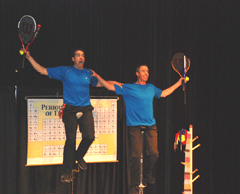
The Amazing Nano Brothers perform at the Museum of Science. Helping educate the general public about nanotech is part of Cambridge’s response to the growing use of nanotechnology in the city. (Photo: Todd A. Carpenter)
ALPERT: How do you go to a research lab and say I want to know how much of this and and this and this you have when everybody makes their nano-materials from a different process?
TAJ: So how do you regulate the unknown?
[CITY COUNCIL AMBIENCE]
TAJ: Cambridge decided that you DON'T - at least.... not yet.
[CITY COUNCIL AMBIENCE]
[VOICE: "... this meeting to order”]
TAJ: At a recent city council meeting, Cambridge city manager Robert Healy presented the taskforce's recommendations: for now, the city isn't requiring companies to disclose usage of nano-scale materials, but it is asking them to.
HEALY: ...Nano very potentially is the wave of the future so it’s dangerous not to watch it but it's dangerous to stifle it.

Businesses and organizations working with nanotechnology in and around Cambridge, Massachusetts (Photo: NanoMetro Map, Courtesy of the Project on Emerging Technologies)
LERER: As many potential benefits as there are to nanotechnology, there are also great risks. And to cut industry loose and focus just on the one side of the nanotechnology that doesn't address the risks, we feel would be socially irresponsible.
TAJ: But Terrence Smith of the Cambridge Chamber of Commerce says the city doesn't want to scare away industries that use nanotechnology - especially when they're already being cautious.
SMITH: Cambridge is an expensive place to do business, so if you've made the choice to be here you've made a significant investment. If you do something wrong, that hurts you in your bottom line. And I have a fair amount of confidence that the people working with these materials are well-trained.
TAJ: Some city officials are less confident. Councilwoman Henrietta Davis praised the city's decision not to regulate nanotech, but says she still has concerns.
DAVIS: Most of the nano stuff that's going on here is at Harvard and MIT, where I think in the university setting, they're very - potentially very careful.
TAJ: Every two years, city health officials will update the Cambridge council on the state of nanotech regulation and research. Sam Lipson, from the Public Health Department says there's still a lot to learn.
LIPSON: Maybe the quality of the questions is the best outcome - maybe that's the most valuable product we're producing because clearly we can’t answer most of them but it may help us look in the right direction.
TAJ: Whatever decisions end up being made - or not made - at the federal level, Cambridge is leaving the door open to regulating nanotechnology in its own backyard.
For Living on Earth, I'm Mitra Taj.
GELLERMAN: For more information about our series on nanotechnology, “Let’s get Small” – go to our website, loe.org. And while you’re at it – let us know what you think about these stories – or others you hear on the show. You can Call our listener line at 800-218-9988. That's 800-218-99-88. Or write to 20 Holland Street, Somerville, Massachusetts, 02144. Our e-mail address is letters at l-o-e dot org. Once again, letters at l-o-e dot o-r-g.
Related links:
- Maynard et. al. study on carbon nanotubes
- Report by Ray Davies on nanotechnology regulations
- The National Nanotechnology Initiative on government oversight
- The Cambridge Nanomaterials Advisory Committee’s recommendations to city council
- The Boston Museum of Science page on nanotechnology
- Listen to Living on Earth’s report on nano-silver here
[MUSIC: They Might Be Giants “Particle Man” from ‘Severe Tire Damage’ (Idlewild Records—1998)]
For Whom the Roads Toll
GELLERMAN: For whom do the roads toll? Well soon they’ll probably be tolling for thee. Next year Congress has to grapple with a new six year transportation bill and tolls are high on their list of ways to make a dent in the estimated 1.6 trillion dollars needed to repair America’s ailing roadway infrastructure. The bill comes due just as high gas prices have had a profound effect on driver behavior. Over the past seven months Americans have driven 40 billion miles less than usual, which means the federal highway tax coffers - dependent on the sale of gasoline and diesel - have shrunk, putting highway taxes and road repairs on a collision course. Christopher Conkey writes about transportation issues for the Wall Street Journal. Hi Chris.
CONKEY: Hey Bruce.
GELLERMAN: Is it really true Americans are driving 40 billion miles less than they usually do?
CONKEY: Indeed, and it’s probably going to get worse if gas prices don’t go down pretty steeply. That 40 billion mile decrease has happened since November, so over the last seven months or so. But May was the third steepest monthly drop ever and if you look at the period from March through May when gas prices started spiking over four dollars that was the steepest three-month pullback we’ve ever seen in people driving on the roads.
GELLERMAN: And, conversely, people are using mass transit more and more.
CONKEY: Uh, indeed, straining the capacity really of a lot of transit agencies who don’t have the money to make capital investments to add more cars, to run longer trains, to add service. And of course over the last few years and specifically in the last two years consumers have been shifting towards more fuel-efficient cars and that is really accelerating as well.
GELLERMAN: This effect of having more efficient cars driving less miles is really putting the hurt on the taxes that the government’s collect—the federal government and the states.
CONKEY: It does. The less gas you’re buying, the less gas tax revenue is pouring into state and federal coffers and that’s the main funding source for mass transit and especially for highways.
GELLERMAN: Now as I understand it ther’re two funds here. There’s the Federal Highway Fund, which goes for roads, and then there’s this Mass Transit Account, which goes for subways and buses and that kind of thing.
CONKEY: Right but they both depend upon gas tax revenue. Basically it all flows into the giant US Treasury fund and then it gets transferred into the Highway Trust Fund which itself has two components, the highway account and then the mass transit account. Of every dollar that flows into the Highway Trust fund, about 80 cents of it goes to highways and about 20 cents goes to transit.
GELLERMAN: But now that highway account is running in the red, it’s what, five billion dollars underwater?
CONKEY: Something like that, it’s a little bit hard to say. I mean the amount of revenue coming into it is about four point five billion to five billion below what the government was expecting even earlier this year. It really is going down which is a really remarkable change for the past, when driving has just increased and revenue flowing into it has increased as well.
GELLERMAN: And now the Bush Administration wants to keep the Highway Fund afloat by borrowing from the Mass Transit Account.
CONKEY: Yeah, they put forward that idea, it doesn’t seem to have any legs in Congress. A lot of people say that this isn’t time to be taking money from the Mass Transit Account, which over time itself may face a shortfall as well if people pull back on driving unless Congress comes up with another way to fund it.
GELLERMAN: The roads are in awful condition you write that what, 25 percent of the nation’s bridges are basically obsolete or structurally deficient?
CONKEY: A little bit over 25 percent of the nation’s bridges are classified as either structurally deficient, as was the Minnesota bridge that collapsed last year, or functionally obsolete. You know, a lot of bridges that are designated as such are still open and can still handle traffic but the bottom line is that just, it’s just a lot that the nation’s transportation department’s have to worry about and keep a closer eye on, and spend more on maintenance, and consider replacing. And you know, this is just going to go up and up because our infrastructure, and our bridges especially, are you know, many of them are 80, 100 years old.
GELLERMAN: So where’s the money coming from?
CONKEY: Well that’s a good question. You know, bridge money comes out of the highway accounts as well and there’s been efforts in Congress to boost that amount. The House passed a bill that would steer about a billion dollars extra next year to go specifically towards bridge repair. And Jim Oberstarr, who chairs the House Transportation Committee and is from Minnesota, he last year floated the idea of raising gas taxes by five cents to fund a couple million more dollars to go to bridge repair as well. That went nowhere given what gas prices are doing. And raising the gas tax remains kind of problematic right now even though a lot of people say that’s what has to happen to really get our funding boosted right now.
GELLERMAN: Boy, talk about a bridge to nowhere.
CONKEY: Yeah, exactly.
GELLERMAN: What about this, I’m reading in your article that the Bush Administration is calling for new highway tolls?
CONKEY: Yeah, well the Bush Administration really loves the idea of tolling. The reason is that they really have a real problem with the way the country right now collects gas taxes, sends it to Washington, then it’s kind of doled out in a little bit of a political way and it also opens the door for earmarking and pet projects that don’t necessarily go to you know reducing congestion or attacking really the big transportation problems the country has. So they love the idea of tolls because it’s a really direct way to finance something. You know if you’re driving on a road, and you’re paying a toll on that road, you are using it and you’re paying a user fee and it’s not being diverted anywhere else, it just goes to pay off a road that’s been financed or something like that. So I think they view it as a little more equitable way too to get people to pay for the roads they use and to not force people who maybe are buying a shirt at a department store to pay a sales tax which is then diverted to this or that. You know, I’d say they really like the economics behind it.
GELLERMAN: You know these E-Z Passes, these transponders you can get for your car to kind of drive through a toll?
CONKEY: Mhmm.
GELLERMAN: Do you ever see a day when you’ll drive out of your driveway and the minute you hit the road you’re being charged?
CONKEY: Everyone is saying this is where we’re heading in the future. Oregon did a study that was ordered up by the last transportation bill that was signed in 2005 in Congress that looked at something called a “Vehicle Miles Traveled Tax.” And basically it’s putting some kind of technology or transponder in your car and it’s recording everywhere you drive, how many miles you drive, and periodically, I believe when you fill up for gas, that information would get uploaded to some federal computer somewhere and you would get taxed based upon how much you have driven, not, as we are now, based upon how much gas we’re buying. So with the gas tax really looking problematic going forward if people are not going to be spending as much on gas, and you know we may be different fuels and we may be using electric cars you know in five, ten years, they’re viewing something like this as another direct way to measure you know how much wear and tear you’re causing on the roads, how much you’re driving. And this seems to really be splitting in a bi-partisan way, everyone seems to say this is something that’s gonna happen in the future. It has privacy issues, as you might imagine, but those’ll probably be hashed out a lot in projects that are going to go forward in the next couple of years.
GELLERMAN: Well Chris thanks a lot, I really appreciate it.
CONKEY: No problem Bruce.
GELLERMAN: Christopher Conkey reports on transportation issues for the Wall Street Journal in Washington, DC.
[MUSIC: Organisation “Smokey Feeling” from ‘Trippin: The Groove Merchant Compilation’ (Luv N Haight Records)]
GELLERMAN: Coming up: A simple solution for clean water - plastic bottles and sunlight. Stay tuned to Living on Earth!
ANNOUNCER: Support for the environmental health desk at Living on Earth comes from the Cedar Tree Foundation. Support also comes from the Richard and Rhoda Goldman Fund for coverage of population and the environment. And from Gilman Ordway for coverage of conservation and environmental change. This is Living on Earth on PRI—Public Radio International.
Related links:
- Read Christopher Conkey's story here
- The American Society of Civil Engineers
- The American Association of State Highway & Transportation Officials
[MUSIC: Bajofondo: “Infiltrado” from Mar Dulce (Decca Records 2008)]
The Way of the Dodo

The last known po’ouli, kept at the Bishop Museum in Honolulu. (Photo: Paul Baker)
GELLERMAN: It’s Living on Earth, I’m Bruce Gellerman.
[PO’OULI CALLS]
GELLERMAN: Listen closely…. Hear it?
[PO’OULI CALLS]
GELLERMAN: That’s the song of the Po’ouli - a small brown bird with a black mask, the size of a sparrow. The Po’ouli was discovered just 30 years ago. It was found on the Hawaian island of Maui on the steep, wet slopes of a volcanic rainforest. Back then there were 200 birds.
[PO’OULI CALLS]
GELLERMAN: And then…there were none.
[END PO’OULI CALLS]
GELLERMAN: The Po’ouli will never sing again. It’s extinct. Alvin Powell recounts the saga of the bird’s unusual discovery and the species’ demise in his new book, The Race to Save the World’s Rarest Bird: The Discovery and Death of the Po’ouli.
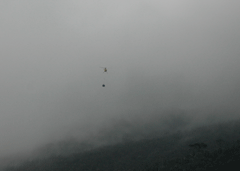
One of two choppers that brought conservationists into Hanawi during the summer of 2006. (Photo: Alvin Powell)
GELLERMAN: So in 1973 somebody spots a bird it looks like another type of bird but no, lo and behold, it’s this one.
POWELL: They called it the Mystery Bird because most of these people had never seen anything like it. There was kind of the thrill of discovery of the bird and then kind of the head-scratching, you know, what the heck do we have here? I mean Hawaii’s been settled for 1500 years, there was no record of this bird amongst the native people’s, there was no record in any of the bird literature, scientific literature, and it took awhile to figure out what exactly they had. At first the initial rush was almost natural tourism – they had a lot of people, a lot of scientists who were interested in birds going in just to really spot the thing. There wasn’t a lot of science done on the bird initially. And it really wasn’t until about ten years later when, a little bit more than ten years, when people working in the forest noticed a lot of damage to the forest from feral pigs that had been released and then they started to see that the bird’s numbers were declining and it was declared endangered within a couple of years under the new Endangered Species Act which was also passed that same year in 1973.
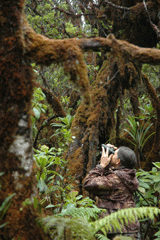
Kirsty Swinnerton, Maui Forest Bird Recovery Project Coordinator, views a bird during a 2006 trip into Hanawi. (Photo: Alvin Powell)
POWELL: It is, it’s quite extraordinary. And the rainforest does still harbor quite a few Hawaiian species, that’s one of the things that is extraordinary about it. When the Polynesians first arrived in Hawaii, all the islands were covered with native Hawaiian plants. And over time the lowlands were almost entirely converted to agriculture, the uplands have been slowly converted to pasture, and today much of Hawaii is introduced plants that we’ve brought there and decided should grow there—sugar cane or pineapple or whatever it is that we’d like. For Hawaiian forest birds, the highlands really are the only place to find them because among these introductions has been the introduction of the mosquito, which was never found on the Hawaiian Islands before. And the mosquito became a vector for bird diseases that had never been seen on the islands that wiped out birds across the lowlands below the area where the mosquito could breed.
GELLERMAN: The efforts to save this bird are enormous. It’s kind of amazing that one little tiny bird should get such attention actually and it takes a tremendous toll on the people who are trying to save it.
POWELL: It really does. And the people in this story, I mean it is the story of a bird, but in my mind one of the most compelling things about this story are the people who go out into this really extreme environment, it’s not just wet, it’s steep. The forest that’s there is very tangled, very dense - I spent a few days in there a couple years ago just to get a taste of it. And you talk about going on a trail through these forests and there’s really no trails what they do is they hang a piece of plastic flagging tape on a tree branch.

A view from above Alvin Powell’s camp in Hanawi. (Photo: Alvin Powell)
GELLERMAN: So what finally does the bird in?
POWELL: It seems it’s the accumulation of all these things just slowly hammering away at the bird. They believe it was once far more widespread than it is now, or was at the time that it was discovered, and that little by little it was pushed back, pushed back, pushed back. Scientists believe that in the rain, this very difficult rainforest where it was finally found, is actually not necessarily it’s ideal habitat and that perhaps this isn’t the ideal habitat to conserve them in and that’s perhaps part of the reason why it was so difficult. The last few birds died of old age, so you could say that old age did them in. And isolation – they are territorial birds. When I became aware of the po’ouli story several years ago there were still three birds around. But the birds were in separate home ranges, they were close to each other, but they were very territorial and they wouldn’t budge from their home ranges. So you had this tragic situation on this high rainy mountainside on Maui where the last three of this species are sitting there near each other, but in separate home ranges, perhaps not even aware of each other.
GELLERMAN: You write in the book about the veterinarian’s attempts to save the bird.
POWELL: That’s one of the most powerful things to me. This gentleman who was the head of the Maui Bird Conservation Center told me about leaving the bird - the bird had been sick for a short amount of time, and this was the last bird, they had captured the last bird in hopes of capturing, at the time there were three, in hopes of capturing the other two into a breeding center to do this last breeding. And the bird had become sick, they had tried everything, they tried a whole bunch of different intensive ways to keep the bird alive. And he told me that when he finally found it dead that he felt in some ways the weight of the world on him because he realized that they hadn’t been able to find the other two in the forest so this very likely was the last one but he also felt relief for this one sick individual. Not only was this bird possibly the last member of its species but it was also an individual and it had been this poor little bird subject to all sorts of invasive procedures and he just kind of felt a little bit of relief to kind of let it go at last.

This is the last known po’ouli. It is now kept at the Bishop Museum in Honolulu (Photo: Paul Baker)
POWELL: I think that some people have learned it, some of the people who are involved, were involved with the po’ouli are still involved with Hawaiian conservation. There is a program with the Maui parrot-bill which is another honeycreeper, there’s a couple hundred of these, they’re not waiting until they get down to very, very few, they have established a captive population and they are looking to establish a second wild population so that you’re not just dependant on this one bird. So I think some lessons have been done, this is one example. But Hawaii has one of the smallest land areas in the United States and it has, I believe, this largest population of threatened and endangered species right now. When you talk to biologists there even though it’s a state, it’s a part of this country, they kind of feel a little bit left out. They feel that a lot of the attention that these species often get passes by Hawaii even though it is kind of the hub of this sort of thing in the United States.
GELLERMAN: Do we have a responsibility, as a species, to save these other species?
POWELL: I believe we do. It’s not just one species, humanity, helping other species. I believe we have a responsibility to set right the things that we have sort of messed up and in Hawaii, certainly, much of the problems of the po’ouli if not all of them are because of introductions, of one kind or another, due to man. And again, we can expand this out around the world. One of the things that attracted me to this story was that this bird and the problems that it faced presented a lens through which to at the large extinction problem on Hawaii and also to look in a broader way at the global extinction crisis that we’re going through right now and I do believe that we have an obligation to do what we can to fix it.
GELLERMAN: Alvin Powell is a senior science writer in The Harvard University News Office. His book is called: The Race to Save the World’s Rarest Bird: The Discovery and Death of the Po’ouli.
[MUSIC: Laurie Anderson “Excellent Birds” from ‘Talk Normal: The Laurie Anderson Anthology’ (Warner Archives—2000)]
Clean Water for Kenya

Plastic bottles filled with water and placed on corrugated metal in the sun are a common site in the Makina area of Kibera. (Photo: Alex Stonehill)
GELLERMAN: Kibera in Nairobi, Kenya, is one of the world’s largest slums. It’s home to about a million people, and a host of problems - violence, poverty, unemployment. But perhaps the biggest threat to Kibera’s residents is the lack of sanitation and clean water. Shortages, and contamination of the drinking water supply led to high rates of disease. But now, Kibera is also home to a campaign to provide a simple, low-cost solution to the slum’s water problem. Jessica Partnow has our story.
[SCHOOLYARD WITH KIDS PLAYING]

Kibera residents stand in line to buy water from a vendor. Because of interruption in the water supply, lines can sometimes be hours long.(Photo: Alex Stonehill)
MUTHINI: This school was started in the year 1999 with around six children, who were orphans. Initially we started a feeding program, but then the vision of educating them came into our mind and we thought that, as much as we feed them, we should also be educating them.
PARTNOW: Teacher Mary’s school gets support from a donor in the Netherlands and scrapes by with occasional government help, like the 100 textbooks they recently received – for a population of 500 students. Education, like most public services here, is unofficial. Even the supply of water comes from a patchwork system, outside the city grid.
Nariobi’s water reaches the outer edge of the Kibera settlement. From there, water flows through a network of low quality PVC pipes into the 25 hundred gallon water tanks that dot the streets.
Much of the water supply is controlled by private vendors, who charge Kibera residents over ten times more than high-income residents of Nairobi, and sometimes create artificial water shortages.
And that’s for water that isn’t always clean. The pipes break frequently, exposing the water to sewage.
Again, Teacher Mary.
MUTHINI: We had so many cases of waterborne diseases. Such like typhoid, cholera, dysentery, just to mention but a few.
PARTNOW: In 2007 the UN Development Programme reported that six in ten infants in Kibera die of waterborne diseases before the age of 18 months.
For residents surviving on less than a dollar a day, paying for fuel for boiling or for chlorine tablets, on top of the price for the water itself, is out of reach.

Kibera resident with empty cup and jerry-can for collecting water. A 20 liter jerry-can costs about five cents to fill. The average family uses between five and seven of these per day.(Photo: Alex Stonehill)
PARTNOW: At a riverbank behind the school sit piles of garbage alongside tin houses and tangled barbed wire. The river here doubles as an open sewer.
[OUTDOOR SOUNDS, BABY CRYING]
MOHAMED: Swahili…laughs…inshallah!
PARTNOW: Thirty year old Habiba Mohamed grew up in Kibera. A black headscarf frames her face. And a flash of gold sparkles from a front tooth as she speaks.
MOHAMED: You see, a toilet facility like this one can be used by over a thousand people.
PARTNOW: She points to an outhouse shared by a thousand people and says rather than stand in line, many residents prefer to use a Flying Toilet. Also known as a plastic bag.
MOHAMED: Like here you can find most of the garbage here – if you had the guts to look – most of it is feces.
PARTNOW: Mohamed works for the internationally funded Kenya Water for Health Organization. She goes door to door trying to convince her neighbors to treat their drinking water using Solar Water Disinfection, also known as SODIS. It’s a low tech approach to cleaning water.
OTIENO: So, this is one way of treating water - drinking water - at the household level, using UV light.
PARTNOW: That’s Joseph Otieno, Kenya Water for Health’s SODIS project officer. He says all you need is a clear soft plastic bottle.

A Masai man washes his sandals in puddles from the previous night's rainstorm. It's estimated that 60% of Nairobi's residents live in slums like Kibera on the city's outskirts.(Photo: Alex Stonehill)
PARTNOW: The sun’s ultraviolet rays interfere with the metabolism and cell structure of bacteria. And they interact with oxygen in the water, creating highly reactive particles like oxygen free radicals and hydrogen peroxides, which further damage pathogens. Six hours in the sun, and the water is safe for drinking.
SODIS was developed in Switzerland and is now used by two million people in Latin America, Africa and Asia. Test after test has shown SODIS produces sanitized water that easily meets World Health Organization guidelines.
OTIENO: We always test our water so that we can assure the community that the water is clean, it is safe, for drinking.
PARTNOW: Some find it hard to believe that SODIS actually works. Habiba Mohamed says she’s even had doors slammed in her face.
MOHAMED: Yeah it happens! You come they say “Ah, they are coming!” whoof! They bang the door. They refuse if from the first day and that remains. And I wish they would refuse it and have an alternative. But they refuse it arrogantly: “I’ve been taking this water for the past 50 years. Who are you to change me now?”
PARTNOW: But Kenya Water for Health reports that 250,000 Kibera residents are now using SODIS. There has been a 20% decrease in diarrhea cases since the programs inception in 2004, and a shrinking need for costly hospital visits.

Plastic bottles filled with water and placed on corrugated metal in the sun are a common site in the Makina area of Kibera. (Photo: Alex Stonehill)
MUTHINI: When SODIS came in, we actually observed a high reduction of the waterborne diseases. That is we had no more complaints, no more pupils coming to complain about waterborne diseases any more.
STUDENTS: SODIS, OH SODIS. Safe water. It is easy to make. Just get a bottle, plus the sun! And your water will be treated. SODIS! How wonderful it is!
PARTNOW: Teacher Mary’s students know all about SODIS. The idea is that children will encourage their parents to use the solar bottles, as well as use them themselves.
But while it’s clear SODIS is making a difference, Habiba Mohamed is quick to point out it’s not a perfect solution.
SODIS doesn’t work on chemical contamination, and can’t be used to treat large volumes of water. During the rainy season, there is often not enough sunlight for SODIS to work. Mohamed encourages her clients to adopt another method of sanitization during that time. Her main goal, she says, is to keep her neighbors healthy.
MOHAMED: Just as long as they don’t take the water like it is. Because we now understand that we’ve a bit tried to take people from taking raw water, to make sure they take a step of improving their water. Because water is life, at the same time water is death.
STUDENTS: Water is important in our life. We need water to drink, cook and so on. Remember: good health depends on clean water. And that is SODIS. How wonderful it is!
For Living on Earth, I’m Jessica Partnow in Kibera, Kenya.
GELLERMAN: Our report on Kibera’s drinking water was funded by the Pulitzer Center on Crisis Reporting. Our website - loe.org - will link you to a multimedia feature about the project.
Related links:
- Multimedia feature on clean water in Kibera
- Solar Water Disinfection (SODIS)
[MUSIC: Partnow: Les Wanyika “Sina Makosa” from ‘East Africa's Finest Rumba's and Other Styles’ (Earthworks—1991)]
LOWN: A nuclear weapon is an instrument of genocide. It’s not a weapon of war. Whom does it kill? It kills not only people, but culture, the environment – it destroys everything.
GELLERMAN: Fighting for peace – no nukes. Next time on Living on Earth.
GELLERMAN: Living on Earth is produced by the World Media Foundation. Our crew includes Ashley Ahearn, Bobby Bascomb, Eileen Bolinsky, Ingrid Lobet, Helen Palmer, Mitra Taj and Jeff Young, with help from Sarah Calkins and Marilyn Govoni.
Our interns are Luke Borders, Kim Gittleson and Jessica Ilyse Smith. Jeff Turton is our technical director. Alison Lirish Dean composed our themes. You can find us at LOE dot org. Steve Curwood is our executive producer. I’m Bruce Gellerman. Thanks for listening.
ANNOUNCER: Funding for Living on Earth comes from the National Science Foundation, supporting coverage of emerging science, and Stonyfield Farm: organic yogurt and smoothies. Stonyfield pays its farmers not to use artificial growth hormones on their cows. Details at stonyfield.com. Support also comes from you our listeners, the Ford Foundation, the Town Creek Foundation, and the Oak Foundation supporting coverage of climate change and marine issues, the Skoll foundation, supporting social entrepreneurs around the world. Uncommon hero dedicated to the common good. Learn more at skoll.org. And Pax World Mutual Funds: socially and environmentally sustainable investing. Pax World: for tomorrow. On the web at paxworld.com.
ANNOUNCER 2: PRI: Public Radio International
Living on Earth wants to hear from you!
Living on Earth
62 Calef Highway, Suite 212
Lee, NH 03861
Telephone: 617-287-4121
E-mail: comments@loe.org
Newsletter [Click here]
Donate to Living on Earth!
Living on Earth is an independent media program and relies entirely on contributions from listeners and institutions supporting public service. Please donate now to preserve an independent environmental voice.
NewsletterLiving on Earth offers a weekly delivery of the show's rundown to your mailbox. Sign up for our newsletter today!
 Sailors For The Sea: Be the change you want to sea.
Sailors For The Sea: Be the change you want to sea.
 The Grantham Foundation for the Protection of the Environment: Committed to protecting and improving the health of the global environment.
The Grantham Foundation for the Protection of the Environment: Committed to protecting and improving the health of the global environment.
 Contribute to Living on Earth and receive, as our gift to you, an archival print of one of Mark Seth Lender's extraordinary wildlife photographs. Follow the link to see Mark's current collection of photographs.
Contribute to Living on Earth and receive, as our gift to you, an archival print of one of Mark Seth Lender's extraordinary wildlife photographs. Follow the link to see Mark's current collection of photographs.
 Buy a signed copy of Mark Seth Lender's book Smeagull the Seagull & support Living on Earth
Buy a signed copy of Mark Seth Lender's book Smeagull the Seagull & support Living on Earth

